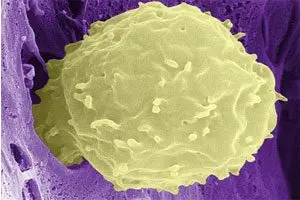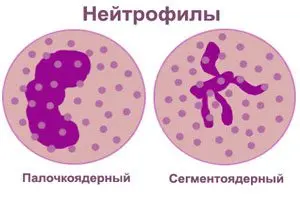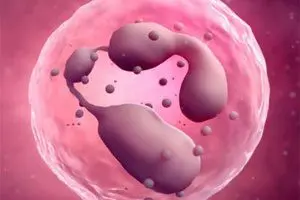Contents

Neutrophilia is an increase in the blood levels of neutrophilic granulocytes. This condition is not normal for a person. Another name for neutrophilia is neutrophilic leukocytosis.
Neutrophils are white blood cells, the number of which exceeds the quantitative values of other leukocytes and granulocytes.
Neutrophils are involved in all inflammatory processes in the body. Their granules are filled with bactericidal substances, and receptors for class G immunoglobulins are located on their membranes. This allows neutrophils to attract antibodies that have specificity for lgG. Neutrophils are the first to go to the site of inflammation and eliminate it. One neutrophil is enough to destroy up to 30 bacteria at a time.
Normally, the level of neutrophils is from 2,0 to 5,5 giga/liter.
Neutrophils can be present in the blood in several varieties:
Myelocytes, which are not normally found in the blood.
Young neutrophils, they can be found in the blood no more than 1%.
Stab neutrophils – from 1 to 5%.
Segmented neutrophils – from 45 to 70%.
Normally, myelocytes and juvenile neutrophils are present in the bone marrow and are reserve cells. Their appearance in the peripheral blood indicates a serious pathology: leukemia or severe inflammation.
If the number of neutrophils in the blood exceeds 5,5×10 G / l, then they speak of neutrophilia.
Causes of neutrophilia

Not always an increase in the level of neutrophils indicates any pathology. Since neutrophils are the first to react to any changes in the body, their number can increase in various situations.
The causes of physiological neutrophilia are as follows:
Overeating (alimentary leukocytosis).
Excessive physical activity.
Emotional shock (emotional leukocytosis).
Premenstrual syndrome in women.
The period of bearing a child (second half of pregnancy).
Childbirth.
Sudden change in ambient temperature.
As a rule, a person does not know that his level of neutrophils in the blood rises. These conditions do not pose a threat to health and do not manifest any pathological symptoms. Therefore, most often a temporary increase in the level of neutrophils goes unnoticed and goes away on its own.
However, if a person experiences certain symptoms of malaise, and an increase in the level of neutrophils is found in the blood test, then this may indicate the following pathologies:
The body has an inflammatory response. It can be any acute viral and bacterial infections, or purulent inflammation.
A person develops a malignant neoplasm.
A fungal infection develops in the body.
The man received some kind of injury, ranging from burns to surgery.
In pregnant women, neutrophilia may indicate eclampsia.
In men and women, spikes in neutrophil levels are sometimes a sign of diabetes.
In the first 24 hours after surgery, the level of neutrophils will be elevated, which is a normal reaction of the body to the intervention. If their indicators do not decrease on the second day after the operation, then this indicates the addition of an infection and requires additional treatment.
With transfusion, the level of neutrophils will be increased. A similar situation is observed against the background of acute blood loss.
Myocardial infarction always occurs against the background of neutrophilia.
Bites of poisonous insects and snakes lead to an increase in the level of neutrophils in the blood.
Types of neutrophilia depending on the degree of nuclear shift in the leukocyte formula

To make a correct diagnosis and prescribe treatment, it is important to take into account the degree of nuclear shift in the leukocyte formula:
There is no nuclear shift. At the same time, the number of mature segmented nuclear neutrophils increases in the blood and general leukocytosis is diagnosed. A similar situation is observed after a hearty meal, after physical effort, with bleeding, or against the background of a mild infectious disease.
Nuclear shift to the left. Neutrophilia is characterized by an increase in the number of polymorphonuclear neutrophils and a small increase in myelocytes. A similar picture of the blood is characteristic of pneumonia, scarlet fever, diphtheria and typhoid.
Neutrophilia is accompanied by a significant jump in the level of myelocytes. This will indicate a severe infection or purulent-septic inflammation.
Neutrophilia with deregenerative nuclear shift. In this case, mutated neutrophils appear in the blood, which indicates severe infections and intoxications of the body, or indicates damage to the bone marrow.
Neutrophilia with nuclear shifts to the left. In the blood there are neutrophils with more than 5 segments. Sometimes they are found in healthy people, and sometimes they are a sign of Addison-Birmer anemia.
Mechanisms for the development of neutrophilia

There are several options for the development of neutrophilia, including:
The process of maturation of neutrophils in the bone marrow starts at an accelerated pace. An increase in the number of neutrophils in the blood occurs within a few days. A similar clinical picture is observed when a person has a malignant neoplasm in the body, or an infection develops that causes the launch of purulent processes. The mechanism of accelerated maturation of neutrophils in the bone marrow is also called chronic neutrophilia. This process is activated against the background of stimulation of bone marrow fibroblasts by cytokines, which are produced by macrophages and monocytes during inflammation or bacterial infection. Bone marrow fibroblasts, in turn, begin to produce hematopoietic growth factors, which are aimed at accelerated maturation and stimulation of the release of neutrophils from the depot. The rate of maturation of neutrophils in this case can be increased by 3 times (with purulent infection) or even more (with diseases of the blood system, with sepsis). The maximum number of neutrophils in the blood is reached after 7 days.
For a long time, the bone marrow is not able to provide the body with neutrophils, as its depot is depleted. This not only reduces their number in the blood, but also reduces life expectancy. The prognosis in this case worsens significantly.
Neutrophils from the bone marrow are released in an immature form, which occurs within a few hours. Such neutrophilia is an acute condition and develops against the background of a pronounced inflammatory reaction. When there are not enough neutrophils circulating in the bloodstream to neutralize it, the bone marrow activates the reserve. To do this, he releases segmented and stab forms of neutrophils. In the presence of acute inflammation in the body, such a reaction will not be launched only when the production of neutrophils in the bone marrow is seriously impaired. For example, when a patient undergoes chemotherapy.
Neutrophilia can develop due to the release of the marginal pool. She manifests within minutes. This neutrophilia is called pseudoneutrophilia. It is launched during emotional upheavals, during intense physical exertion, during treatment with catecholamines due to an increase in the release of blood by the heart. All of these reasons lead to the fact that the speed of blood flow through the vessels increases, while leukocytes occupy a marginal position, the number of monocytes and lymphocytes increases.
Neutrophilia with a decrease in the release of neutrophils from the bloodstream into the tissues. Neutrophils from the vascular bed can enter the tissues if they have certain structural defects. These can be congenital or acquired diseases. Modified neutrophils occupy the marginal position in the vessels, and then leave their bed. Therefore, a similar situation can develop with almost any infection.
Neutrophilia, which develops under the influence of several factors. At the same time, several mechanisms will be simultaneously launched, leading to an increase in the number of leukocyte cells.
Symptoms and signs of neutrophilia

Neutrophilia is not a disease, so it is impossible to list its symptoms. They are determined by the violation that provoked the jump in neutrophils.
Therefore, if you experience the following symptoms, you should consult a doctor and take a blood test:
Increased body temperature.
Weakness and malaise.
Pain of different localization.
Episodes of loss of consciousness.
Increased sweating, not associated with objective causes.
A sharp deterioration in well-being.
Unexplained weight loss.
Bleeding from the digestive tract.
What can affect the test results?

Sometimes a doctor, with an increase in the level of neutrophils in the blood, recommends that the patient retake a blood test. It is possible that the specialist has some doubts about the purity of the study. To eliminate the possibility of diagnostic inaccuracy, the following recommendations must be followed:
A blood test must be taken strictly on an empty stomach. The use of pure non-carbonated water is allowed.
Before taking a blood test, you need to exclude physical overwork and emotional overload.
It is important to avoid sudden changes in temperature, as this can provoke an increase in the level of neutrophils.
During pregnancy, neutrophils can be elevated, which is normal.
Treatment of neutrophilia

Neutrophilia is not an independent disease. It only indicates that something is wrong in the body. To begin treatment, it is necessary to find out the exact cause of neutrophilia. Therefore, the patient must undergo a comprehensive diagnosis.
When confirming infectious processes in the body, antiviral, antibacterial or antimycotic treatment is required (depending on the type of pathogen). To increase the body’s resistance, immunostimulants can be prescribed. Corticosteroids are indicated when the patient has rheumatic lesions. Emotional neutrophilia requires the appointment of sedatives. In severe cases, leukapheresis is performed. This procedure allows you to cleanse the blood of excess leukocytes.
The level of neutrophils is the most important indicator of the health or ill health of the patient. It must be taken into account when conducting a blood test.









